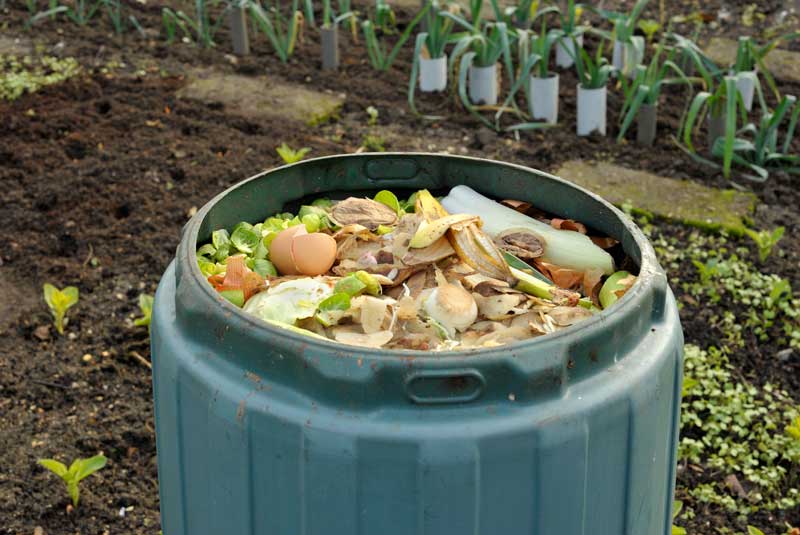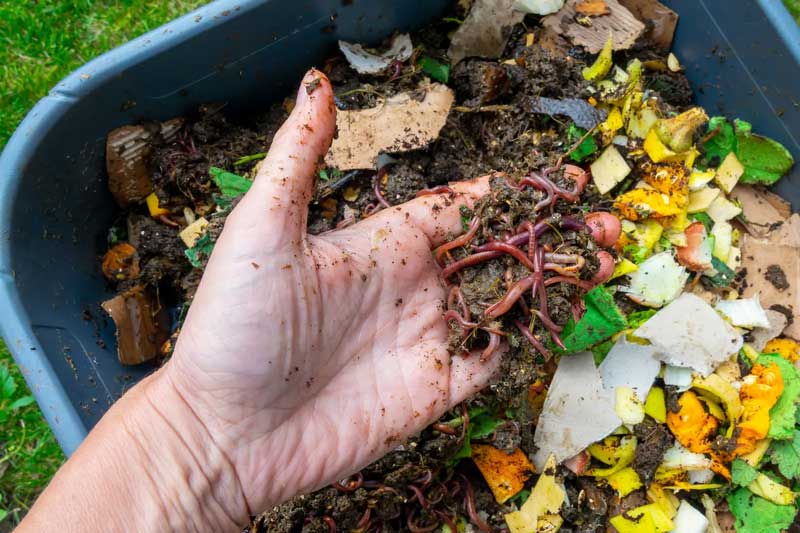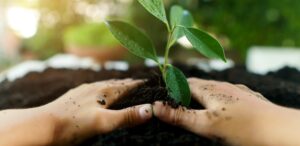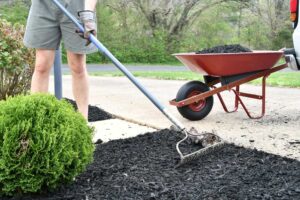What do you think when you hear “composting?” A pile of decomposing lawn clippings in a backyard? That thing that one friend you have keeps trying to get you to start? That weird, third bin next to the trash and recycling? In truth, all of those and more fall under the composting umbrella.
Composting has a long and diverse history, spanning back potentially as long as humans have run farms. There are plenty of benefits and basics to know about composting yourself, but to get the full picture you need to appreciate its full scope from the small, at-home projects to the large, full community operations.
In this article, we’ll explore the different types of composting methods.
Small-Scale Composting Methods
For the individual, small-scale composting is what they will most likely directly interact with. This is a green alternative to simply throwing everything out, and if you grow your own plants, it’s a way to make cheap fertilizer. But what’s the best way to compost at home? That depends on what makes the most sense in your living accommodations. Each type of composting has positives and negatives, so do your research to figure out which method makes sense for you. Here are some different ways to compost at home:
Onsite Composting
The cheapest, easiest, and most popular small-scale composting, onsite composting can also be referred to as open-air composting or direct composting. This method involves creating a compost pile at the location where organic waste is generated, making it ideal for beginners or homes with minimal compost production. It can include various composting methods such as:
Open Air Composting
Also referred to as hot composting, this specific method involves piling organic materials in a designated area and aerating them by turning. Microbial activity generates heat, which helps speed up decomposition. This type of onsite composting is typically done in an open space to maintain aeration and temperature.
Pros:
- Easy to set up and maintain: Requires minimal equipment and can be done in various locations.
- Highly effective: When managed properly, it produces nutrient-rich compost relatively quickly.
Cons:
- Requires regular turning: To maintain aeration and temperature, the pile needs to be turned regularly.
- Takes longer to decompose than other methods: While faster than some techniques, it still may take several months to a year.
- Potential odor and pest issues: If not managed properly, food scraps may attract pests and create odors.
Direct Composting
Direct composting (also known as in-ground composting) is where organic materials are buried directly into the soil to decompose. This method simply requires digging a hole or trench in the ground and burying food scraps or plant materials in it, then relying on the natural process of the soil to break it down.
Pros:
- Simple and straightforward to implement: Requires minimal effort and setup.
- Utilizes the existing soil ecosystem: Natural decomposition processes occur without the need for tuning.
- Minimal odor and pest issues: When properly executed, buried scraps are less likely to attract pests.
Cons:
- Slower decomposition process: Takes longer for materials to break down compared to other methods.
- Limited control over the composting environment: Less ability to manage temperature and moisture.
- Not suitable for all types of organic waste: Large items or certain materials may not decompose effectively when buried.
Worm Farm Composting
Worm Farm Composting or “Vermicomposting” utilizes a specific structure tailored for worms to break down food scraps, yard waste, paper and other organic material into high-quality compost also known as “castings.” These worms aren’t your normal night-crawlers, vermicomposting utilizes red worms to properly break down the compost. One pound of mature red worms can work through a half pound of organic material a day. The farms can be bought or built to the scale needed for your home, but avoid using metal as copper can leach into the soil and kill the worms. Worm farm composting is similar to Effective Microorganisms Composting, using worms instead of bacteria.
Pros:
- Creates versatile compost: Suitable for potted plants and a wide range of gardening applications.
- Produces high-quality liquid fertilizer: Known as “worm tea,” it enhances plant growth.
- Faster than compost piles: Produces usable castings in just three to four months.
- Ideal for small spaces: The compact structure works well in apartments or small offices without yard space.
Cons:
- Liquid “worm tea” can leak: Indoor farms require management of excess liquid to prevent messes. However, storing the farm outside allows the liquid to naturally seep into the soil.
- Worms require maintenance: They are sensitive to environmental conditions, and extreme temperatures or direct sunlight can harm or displace them.
- Indoor storage requires climate control: Keeping the farm indoors ensures consistent conditions, but proper drainage collection is necessary.
Tumbler Composting
Tumbler composting offers an effective and user-friendly approach to composting by utilizing a rotating container specifically designed for this purpose. The enclosed nature of the tumbler facilitates easy mixing and aeration of organic materials, which helps speed up the decomposition process. By simply rotating the tumbler, users can ensure that oxygen circulates throughout the compost, promoting uniform breakdown.
This method is particularly suitable for those with limited outdoor space or for individuals seeking a more organized and controlled composting experience. Tumbler composting is versatile, accommodating various organic waste types, including kitchen scraps and yard trimmings, while keeping the composting area clean and minimizing unpleasant odors.
Pros:
- Facilitates rapid decomposition: Produced usable compost within just a few weeks.
- Compact design: Perfect for small yards or patios with limited space.
- Reduces pests and odors: The enclosed environment minimizes common composting issues.
Cons:
- Requires physical effort: Rotating the tumbler can be challenging for some users.
- Smaller capacity: Typically holds less than traditional open compost piles, making it less ideal for larger households.
- Initial cost: Purchasing a tumbler may be a barrier for some individuals due to the upfront expense.
EMO Composting
EMO (Effective microorganism) composting is a versatile method that utilizes a blend of beneficial microorganisms to enhance the decomposition of organic materials, making it suitable for both indoor and outdoor settings. Commonly associated with the Bokashi system, this approach typically involves a two-bin setup, where one bin is filled with kitchen scraps while the other rests, promoting fermentation. Users can collect nutrient-rich liquid byproducts, known as “Bokashi juice,” for gardening, but some kitchen scraps, like citrus and spicy foods, should be avoided. EMOs can also be purchased online and are compatible with various composting systems, improving the overall composting process.
Pros:
- Accelerated decomposition: Produces usable compost within weeks.
- Enhanced nutrient content: Significantly enriches soil health for better plant growth.
- Odor reduction: This makes it more suitable for indoor composting environments.
Cons:
- Higher initial investment: Microbial inoculants can be costly upfront.
- Requires monitoring: Moisture and temperature need to be carefully managed for optimal resutsl.
- Limited composting materials: Some kitchen scraps are not suitable for EMO composting.
Large-Scale Composting Methods
Individual composting is a good practice to get into, but community composting is where it becomes the most efficient. While requiring a higher initial overhead cost and management limits the accessibility of these methods, once the systems are in place the process can be streamlined. If in an apartment, look to see what services are offered, and if in a home, check what types of composting services your local disposal companies offer (you can often have compost picked up by the same people who take your trash and recycling).
Mechanical Composting
Mechanical composting refers to methods that use specialized equipment to enhance the decomposition of organic materials, making the composting process more efficient and effective. This approach is particularly advantageous for large-scale operations, such as commercial composting facilities, where managing substantial volumes of organic waste is necessary. By automating key processes like mixing, aeration, and temperature monitoring, mechanical composting reduces the time required to produce high-quality compost.
Some common systems within mechanical composting can include windrow and aerated static pile composting (more on these composting methods below).
Pros:
- Enhanced speed: Capable of producing usable compost in just a few weeks.
- Reduced manual labor: Ensures the production of high-quality compost with controlled conditions.
Cons:
- Costly initial setup: Requires specialized machinery and infrastructure, which can be expensive.
- Ongoing maintenance: Equipment upkeep adds to operational costs and may cause downtime.
- Less adaptable to materials: Mechanical systems may not handle diverse organic materials as effectively as traditional methods.
Aerated Static Pile Composting Composting
This method utilizes a systematic and large-scale approach to composting that’s perfect for certain landscaping companies, farms or communities. This system works by homogeneously mixing organic waste into large piles, aerated by layers and bulking agents and placed over a network of pipes that utilize blowers to circulate airflow.
Pros:
- Ideal for large generators: Handles large amounts of yard waste, food scraps, paper products, and other organic materials.
- No physical turning required: Reduces labor and simplifies the process.
- Cold-resistant: The core retains warmth, allowing composting to continue through colder weather.
- Produces compost relatively fast: Ready in three to six months.
- Space-efficient: With the proper airflow system, large-scale compost piles save on total land use.
Cons:
- Requires detailed layering and monitoring: Without turning, aerated static pile composting needs careful management to ensure even heating and aeration.
- Costly setup: Installing the pipe system for airflow circulation can be expensive and requires technical expertise.
- Not suitable for certain materials: Animal by-products and grease do not compost well with this method.
Windrow Composting
Windrow composting is a common, large-scale solution to high volume communities and organizations like restaurants. The organic waste is piled into long rows, or “windrows,” that sit at four to eight feet tall and fourteen to sixteen feet wide. These dimensions allow the piles to be large enough to maintain temperature, but small enough to allow natural airflow. This process produces a lot of compost, so many communities give it away for free!
Pros:
- Handles a wide variety of waste: Suitable for yard trimmings, grease, liquids, and even animal byproducts.
- Works in cold climates: High internal temperatures allow composting to continue in colder environments.
- Easy and cost-effective: Relatively simple and inexpensive to set up and operate.
Cons:
- Requires large land and resources: Needs extensive land, designated equipment, and consistent labor to maintain and turn the piles.
- Risk of contamination: Produces a liquid byproduct that can contaminate local groundwaster if not properly collected and treated.
Both Small and Large-Scale Composting Methods
In-Vessel Composting
This method can be scaled to the needs of the situation depending on the size of the composting unit. A drum, silo, trench or similar equipment is filled with organic material and mechanically turned, allowing for control and minimal used space. These units can range from being used inside a building’s kitchen to large, outdoor units for whole communities.
Pros:
- Unparalleled control: Regulates aeration, climate, byproducts, and odors with both indoors and outdoor units.
- Minimal space required: Efficiently operates in small areas.
- Handles diverse organic waste: Suitable for nearly all types, including meat and manure.
- Fast composting: Produces usable compost in just a few weeks.
Cons:
- Expensive and complex: Units are costly and require technical knowledge for proper operation and maintenance.
Ready to start composting? TDS can help
Now you know what types of composting methods are out there, it’s time to see what you can do. If you have the space and the initiative, start composting at your home, but if you’re renting or don’t have the time, find a local service to help.
As of October 1st, 2024, multifamily properties with five or more dwelling units are responsible for providing residents and employees with convenient access to commercial composting services in Austin, Texas. This includes apartments, condos, dorms, assisted living facilities and nursing homes. You can learn more about the steps you need to take here.
At TDS, we offer various services to help multifamily properties with their waste streams, including roll-off dumpster rentals, waste pickup and recycling programs. We ensure your property can meet compliance with the Universal Recycling Ordinance.
Learn More:













